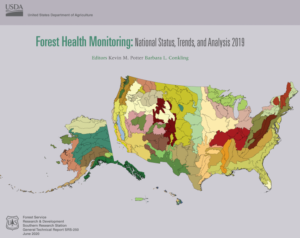
Scientists from across the Forest Service, as well as university researchers, state partners, and other experts contributed to the 2019 FHM report.
Every year, the USDA Forest Service Forest Health Monitoring (FHM) program tracks changing forest conditions, including national assessments as well as focused regional analysis. The resulting report is the only national summary of forest health undertaken on an annual basis.
Forests constantly change as a result of tree growth and mortality, weather events and climate trends, and disturbances from stressors including fire, insects, and diseases. The goal of the 2019 FHM report is to identify ecological resources whose condition is deteriorating, potentially in subtle ways, across large regions.
Scientists from across the Forest Service as well as university researchers, state partners, and many other experts contributed to the 2019 report, which is available as a General Technical Report titled Forest Health Monitoring: National Status, Trends, and Analysis 2019.
Kevin Potter, a North Carolina State University scientist supported by the Southern Research Station, edited the 2019 report with fellow NCSU scientist Barbara Conkling. Each year, data from the previous year are used to inform the current year’s report.
“A lot of effort goes into collecting forest health data each year across the country, by people in field crews and in airplanes, and by satellite sensors,” says Frank Koch, who represents Forest Service Research on the FHM Management Team. “The job of the FHM reports is to make sense of these data. That’s a challenge, but an important one because it helps inform decisions about how to manage our forests.”
Individual report chapters are available for download, along with the full series of FHM annual reports since 2001. Users can search reports and chapters by year or topic. Highlights and additional resources are also included.
“It’s always interesting to see such stark differences between the East and the West in the issues that are affecting forests,” says Tom Eager, FHM national program manager. “The forests in the two regions are very different, of course, so it’s not a surprise they have different forest pests. At the same time, there was a dramatic difference in precipitation, with almost all of the West in drought and almost all of the East in moisture surplus in 2018.”
Potter, Conkling, and the other authors have completed a draft of the 2020 FHM report and expect its publication in the summer of 2021.
Read the full text of the report.
For more information, see this blog posting from the U.S. Forest Service Southern Research Station.
October 11, 2020




